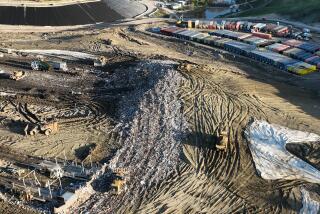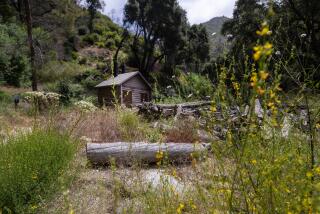Repairs at Shifting Golf Course Being Considered
Glendaleâs Scholl Canyon golf course sits atop nearly 300 feet of buried garbage, high enough that on clear days players can see past downtown Los Angeles as far as Catalina Island.
But the landfill beneath the scenic nine-hole municipal course continues to shift and settle, creating spots with four-foot-deep fissures and almost vertical greens and releasing enough methane gas to power 2,500 homes.
Local players agree that the course is tough, with its topography akin to an unmade bed. Said course superintendent Dave Nobbs, âIf you can putt here, you can putt anywhere.â
âBall Will Roll Off Greenâ
âItâs a frustrating little golf course,â said Mal Stich of Glassell Park, who plays there regularly. âYou can be three feet away from a hole, but, if you miss the putt, the ball will roll all the way off the green. Some greens are so steep you almost have to stick your spikes into the ground to keep from falling down.â
In the next few weeks, the Glendale City Council will consider whether to spend $125,000 to $150,000 to rebuild some greens and tee-off areas that have become almost unplayable and to replace water pipes that have been eaten away by methane.
Despite the smell of gas and the shifting playing surface, golfers using the course--and the green fees paid--have increased each year since Scholl Canyon Golf and Tennis Complex, at 3800 E. Glenoaks Blvd., opened in 1981. Gross receipts from the operation have increased an average of $4,000 a month, to an average of $12,000 a month, since October, 1984, compared to the previous 12 months, according a city report.
Monthly revenues from the 10 tennis courts there, which are not over the landfill, also have increased.
Course operator Jeff Silverstein said Scholl Canyon will never be a first-class golf course. But, with its competitive prices and expected city improvements, the 1,700-yard course will continue to be one of the best courses in the area for seniors, women and beginners, he said.
âItâs short but challenging,â Silverstein said.
Greens fees at School Canyon are $3 for nine holes on weekdays and $4 on weekends; other municipal courses in the area charge up to $10.
Those familiar with golf courses built on former landfills say that, if the city wants to protect the more than $1.5 million it has invested in the course, Glendale will have to continue paying for improvements for 20 years.
âWeâve been rebuilding tees and greens annually,â said Bob Holtzen, superintendent for the private Mountaingate golf course that was built on a county landfill in West Los Angeles 12 years ago. âThere is constant shifting, and you have to rebuild tees and greens if you want to keep up with the movement.â
At Victoria golf course in Carson, completed in 1964, settling has slowed but methane continues to kill grass, course superintendent Jim Janosik said. Carsonâs other landfill course, the 15-year-old Dominguez Hills, is still moving dramatically, he said.
Scholl Canyon superintendent Nobbs said he has seen the course change dramatically in the six months he has worked there.
âEach hole changes with the settling,â Nobbs said. âSome of the greens that used to be bad greens have become better ones. Some get leveled out and then get bad.â
In some areas of the course, where garbage underneath the one- and two-foot soil surface is moving, fissures as deep as four feet open and must be filled with dirt.
Methane gas created by decomposing materials in the landfill rises to the surface, killing grass in some areas, Nobbs said. Trees are either stunted or die after trying to root in the soil and garbage.
Nobbs believes that the methane has caused the soil to harden in some areas and become almost like cement. After a recent rain, puddles remained in low spots on the course for more than a week, unable to soak into the hardened soil, he said. Compounding the drainage problem are areas of the course where drain grates have risen above surrounding terrain, making them useless.
The strong-smelling gas has eaten away much of the courseâs metal sprinkler and water-pipe system, Nobbs said. The pipes are gradually being replaced by plastic ones that can withstand the methane and have greater flexibility to accommodate constant movement.
âWe regularly get broken water lines because of the shifting,â Nobbs said. âA couple of weeks ago we had four broken lines in one week.â
Some local golfers tell a story about problems caused by the methane gas, which leaves a constant smell: A woman who was smoking a cigarette while attempting to get a drink of water from a fountain near where some gas was leaking caused a small explosion, they say. City officials said they never received a complaint about such an incident.
The city has 27 methane recovery wells underneath the course and burns the gas at an adjacent methane power plant. The methane provides about 1% of the electricity generated by the cityâs utility operation. Were it cleaner, enough gas could be collected to provide all the electricity needed by 2,500 homes, power management director Ron Stassi said.
Glendale pays Silband Sports Corp., formerly California Golf Centers Inc., $52,000 to operate and maintain the complex. The city also pays about $65,000 a year for utilities.
The city hopes that, by improving the 50-plus-acre course, it will become profitable enough by next October to charge Silband $50,000 a year to run it, as provided in a three-year contract that began last year with Silband.
Silverstein, president of Silband, said he must increase the number of rounds played if he is to start paying the city and still turn a profit.
âWith increased improvements and greater public awareness, we hope to build up the course so that it will be profitable without a city subsidy,â Silverstein said. âIt remains to be seen if that will be possible. Based on the numbers now, it would not be profitable.â
The Scholl Canyon complex, which includes the tennis courts, a snack bar, driving range, golf cart rentals and pro shop, had cost the city an average of $200,000 a year during the three years it was operated under a previous concessionaire, William L. Henry. The cityâs maintenance and utility costs were always much higher than its share of receipts from the operation.
A year ago, Silband underbid Henry for the Scholl Canyon contract and has reduced city losses by increasing the number of customers and the revenues. But maintenance problems caused by the landfill have continued to plague the course.
Finding a public use for full landfill sites prompted construction of courses such as Scholl Canyon, said Henry Agonia, Glendaleâs director of parks and recreation. He said problems at Scholl Canyon have been overstated.
âThe course is not as serious a problem as people think,â Agonia said. âFortunately, with the nature of golf, you donât need a level spot . . . except for a fairly level area to putt on and to tee off.â
Agonia said he could not predict whether the city will continue to pay for improvements at Scholl Canyon because it is impossible to know what work the course will need.
âAfter we do this work, weâll evaluate it in a year or six months and see what we want to do,â he said.
If the course improvements are approved by City Council, Silverstein expects to have the work completed this winter. The course will remain open using temporary greens while the work is being done, he said.
A quarter of the parking lot is filled with dirt in anticipation of council approval. And regular users of the course say the work is long overdue.
Glendale High School junior Brian Carvalho was playing the course last week, honing his âmid-iron and short gameâ for his expected move up to the schoolâs varsity golf team in the spring. He said he plays the course every Friday.
When told of the expected city improvements, he said he hoped that the plans include rebuilding the fifth green. âItâs like putting up a wall,â he said.
More to Read
Go beyond the scoreboard
Get the latest on L.A.'s teams in the daily Sports Report newsletter.
You may occasionally receive promotional content from the Los Angeles Times.










